Garden photographers just love focal points designed into gardens. In great gardens though, they present dilemmas. What is the best angle ? Let’s take a stroll around one of the rooms in Gary Ratway’s own garden:

Gary is one of those exceedingly rare landscape architects who knows more than 25 plants. Not only does he know more plants than any designer I know, he and his wife, Deborah Whigham, started Digging Dog Nursery just so he could have the plants he wanted. In the photo above, the nursery is just beyond the upper path (north).
It is a delight to be in a complex garden that has great vistas at every turn, mystery down every path. Gary has designed a series of garden rooms, using hornbeam hedges and rammed earth columns to define each space and often places large planters along axial views as focal points that pull the eye from one garden to the next.
A beautifully designed room like this one has photo opportunities galore. (To orient this tour, the path running left to right is south to north.) I find myself slowing down, eyes wide, imagining every purpose to every photo and will use the focal point container of Silver Sword (Astelia chathamica) in each of the following photos to illustrate how the camera can use the same focal point to tell different stories.
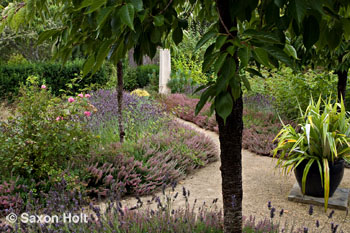
This next photo is taken from exactly the same point as the opening photo, I have just used a different lens. The first photo uses a super wide 18mm lens, simultaneously making the room seem larger than it is and showing the quadrant design with paths joining at the focal point. Now I am tighter for more intimacy.
I like this photo quite a bit and spent quite a bit of time composing it. At first glance it seems slightly off balance, but this technique serves to make the viewer look more closely and study the image. This is an intimate, personal view using three of the cherry trees to weight one layer of the photo while showing the path connecting two focal points – the container and rammed earth column. I could get philosophical about aesthetics and composition using this one photo and then fill the entire post about my idiosyncratic eye, but will save that for a workshop one day. Let’s have more fun with the focal point.

I have moved over to the south path we first saw on the left in the opening and look back to the center. Using the tripod to help nail down an exact composition, we see the container dead in the middle, now seeing all four of the cherry trees framing and reinforcing the focal point. It is hard to tell in this small blog photo, but in the distance we see another container with an ornamental grass in another garden room. We will come back to this axial view.
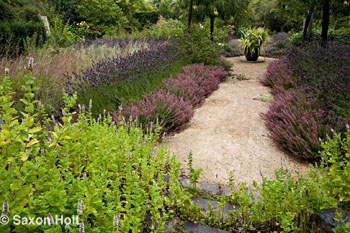
An all together different story is told with this angle, taken from almost the same point as the tighter one previous, but now with the wide lens. You can tell it is not the exact same point because the two containers do not line up precisely, but the story here is different – the stone steps crowded with Hyssop leading into the garden, the path with focal point to pull the eye into the garden, and the carefully chosen layering of plants: Germander (Teucrium chamaedrys) and lavender which frame each quadrant.
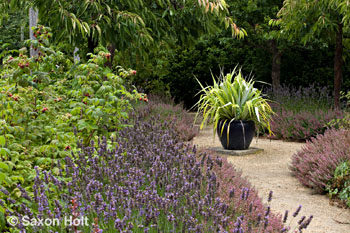
I have now moved to the west side path entering this garden room, looking into where I took the opening photo. Note some of the same same plant material, Lavender and Teucrium, now framing a quadrant of raspberries, and the same focal point. There are so many subtle aspects of this garden to be photographed and the photographer must decide how to use the camera, letting each photo “lie”, letting each photo tell a different story.
The focal point helps the composition, but the story here is complex: about the plant layering – color, texture, size of the plants; about edible gardens; about drought tolerant and sustainable practices; about garden design.
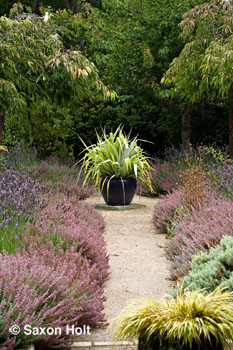
Let’s back out of this same path. Immediately we know this photo is about the focal point. Now notice the secondary pot, which is helping to anchor the photo composition and hint at another garden room.
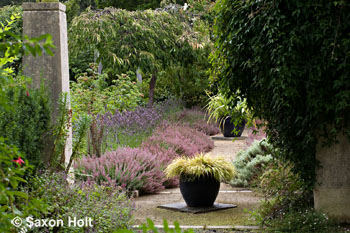
This photo is about garden rooms and entrances, yet I am still using the container of Silver Sword to pull you into the room. Well, actually it is Gary who is using the focal point to draw us in, but the photograph must be composed to bring this idea home.
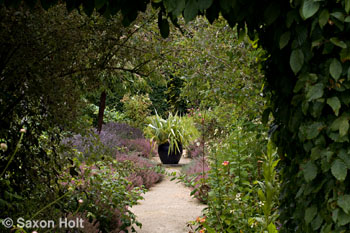
The secret garden
This final photo is from the north entrance to the garden looking through the hornbeam hedge, to what now seems a secret garden. It is right where the container of ornamental grass is seen in the long axial view of the third photo in this post, now looking south.
What is the “best” photo in this garden ? What a dilemma a photographer has when faced with such a fine subject! There is no one best photo, each depends on what you see and what you want to say. In each one though, there is the design element of a central focal point that helps the composition.
As a photographer, first slow down to “see” a garden, decide what you want to say, and compose tightly. When the designer provides a focal point, it makes it so much easier.
